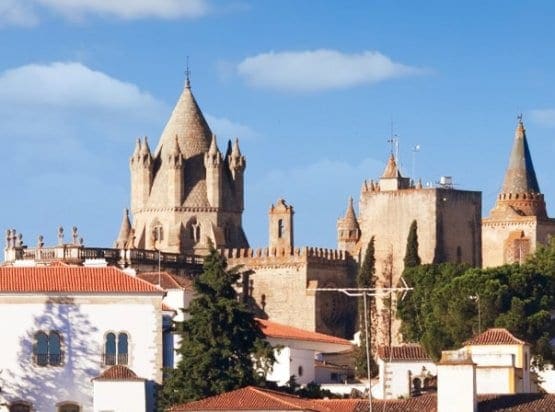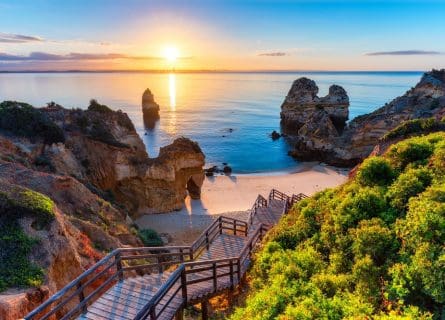Uncover Evora's vibrant flavors and culinary gems with our expert guides. Plan an unforgettable trip now!
Read more
EXPLORE ALL OUR GUIDES TO PORTUGAL'S WINE REGIONS
Last updated: January 4, 2024
The Algarve is, at last, starting to gain recognition for the thrilling quality of its best wines. After an inauspicious start – lazy co-operatives spent the 1900s churning out tourist plonk – this corner of southern Portugal is earning the respect of its peers. The region, already renowned for its pristine beaches and whitewashed villages, has become a magnet for outside investment; millions of euros have flowed into these once-neglected vineyards as winegrowers seek new terroirs in the face of rising demand for hand-crafted labels. In the 20th century, Algarve invited snorts of derision from international buyers and sommeliers. However, those days are long gone.
Indeed, every year brings good news for the Algarve’s burgeoning wine industry. The awards keep rolling in: overwhelmingly for the potent red blends that are a trademark of southern Portugal. Meanwhile, a campaign to market the region to international consumers is gathering momentum. The Algarve’s tourism helps spread the word, and the region is justly celebrated for its superlative gastronomy; the coastline hosts several Michelin-starred restaurants. So sip a glass of Touriga Nacional and marvel at the unspoiled beauty of Europe’s premier seaside resort. But remember: there are terrific dry whites and fizz from indigenous grapes found all over the country. Saúde!
It is tempting to pigeonhole the Algarve as a vacation ‘Disneyland’ for North Europeans, blessed with endless days of bright, cloudless sunshine. Yet the region has played a pivotal role in European affairs since the days of the Romans, who arrived in 216 BC. Wine production, already popularized by the Phoenicians and Greeks, became a major part of the Algarve’s economy during the Roman tenure. The most striking example of this cultural legacy can be witnessed at the Roman ruins of Milreu, where historians believe over 20,000 liters of wine were produced yearly. However, the collapse of the Western Roman Empire in 476 AD led to a significant decline in wine production. Most of the Iberian Peninsula was overrun first by Germanic tribes, then by Moors from North Africa.
Nevertheless, winegrowing saw a modest renaissance during their long reign, albeit the alcohol produced was used for medicinal purposes. The Moors were taken with the Algarve, naming the Al-Gharb Andalus region. But despite the many achievements of their civilization, reconquest by the Christian kingdoms began in earnest in the 11th century.
By the Middle Ages, a small county in the kingdom of Castilla y Leon had been granted independence by its ruler, Afonso Henriques. Known as Portucale, the monarchy sought the help of English knights to push south from Lisbon into the Algarve in the 12th century. After that, wine growing was re-established as a key part of the local economy, with sweet, concentrated reds sent to Portugal’s colonies in India and South America. Unfortunately, as Portugal’s fortunes declined in the 18th and 19th centuries, so too did its vinous reputation. Under the rule of the dictator Antonio Salazar, co-operatives sprung up across the nation, as Salazar was keen to centralize wine production across Portugal; yet this was hardly a boon for quality in regions like the Algarve, as its members were content to market cheap and cheerful plonk.
Fortunately, the 21st century saw individuals move in as the co-operatives lost their dominance over local wine growing. Moreover, Portugal’s best winemakers are spreading their wings and visiting their talents on emerging terroirs and subregions. The best, as they say, is yet to come.
Whether the Algarve is a serious challenger to Alentejo is a good subject for debate; the latter region has had longer to work on its act. But there is no doubt that the balmy climate and dry autumns are highly conducive to quality wine growing. Separated from Alentejo by the Monchique mountains, rainfall during harvest time is almost unheard of along the Portuguese south coast. Instead, growers can anticipate warm sunny days and cloudless skies extending into October – sometimes November! This is why late-ripening varieties, such as Syrah and Touriga Nacional, are the first choice for many Algarve producers. Left on the vine until September, the berries are packed with sugar, ripe tannin, and flavor. Indeed, achieving full physiological ripeness in the Algarve is seldom a challenge. One could even say it comes all too easily.
Of course, there is a downside to abundant sunshine and warm evenings. Specific sites are liable to produce ‘cooked’ wines: flabby and cursed with unwieldy alcohol – the inevitable concomitant of all that sunshine and heat. For that reason, many growers have become fixated on seeking higher-elevation sites that offer all the benefits of diurnal temperature variation. This refers to a significant difference between day and night temperature, helping preserve the grapes’ acidity. Soils are another vital part of the quality equation: calcareous terroir, cold and free-draining, is ideal for cultivating white grapes. But there are also outcrops of sand close to the coastline and metamorphic schist. The latter suits Touriga Nacional down to the ground. As elsewhere, vineyard sites near the sea enjoy cooling breezes that help to moderate intense summer heat. They can be a godsend in July and August.
Winemakers in the Algarve play by their own standards and rules. For example, most growers prefer to work under the Vinho Regional Algarve designation despite an established appellation framework. This affords a great deal of freedom to oenologists, including the varieties they work with and the methods they employ. Yet the flexibility on yield isn’t always a blessing when quality is concerned; leading brands will always crop at far lower than the permitted levels. A raft of investments, meanwhile, has endowed all the best wineries with the standard paraphernalia of modern equipment: stainless steel, analysis laboratories, barrel cellars, and sorting machines. Nevertheless, the techniques used will vary significantly, ranging from hyper-protective winemaking to skin contact and maturation in amphorae.
Regarding regional demarcation, the region boasts four distinct DOCs (Designação de Origem Controlada). They are Lagos, Portimão, Lagoa, and Tavira, running from west to east. Lagos is renowned for its robust reds and full-bodied whites – managing alcohol levels can be an issue here. Likewise, the subregion of Lagoa is associated with potency and strength, although earlier harvests can make a difference. Portimão, meanwhile, is the smallest zone in the western Algarve. Its forte seems to be Touriga Nacional Syrah blends of incredible richness and poise. Finally, Tavira is the place to seek out saline whites and medium-bodied reds due to the cooling influences of the ocean and site elevation.

The Algarve – and its wines – are innately seductive. Deeply passionate and utterly committed to sustainability, its community of winegrowers can offer you original flavors, a passion for hospitality, and a surfeit of natural beauty. The vineyard, located in the heartland of a major tourist zone, is a serene paradise filled with indigenous grape varieties, beautiful beaches, and award-winning restaurants. From the perspective of the wine lover, there is little, if anything, to dislike. Export markets are still embryonic, but visitors can speak to the quality and originality of local wines. Despite market pressure to increase white production, many of the region’s best bottles are concentrated red blends. Touriga Nacional and Antão Vaz are hot favorites, although Syrah can also be exceptional. Moreover, prices remain very stable and reasonable.
However, it’s not all plain sailing in the sun-kissed vineyards of the Algarve. A series of torrid vintages has tested the limits of vine cultivation in the region and the availability of irrigation water! In southern Europe, heat and drought can equal flabby and ‘baked’ wines – a vine’s metabolism races ahead in hot weather, often reaching high sugar levels at the expense of acidity. Picking times are, therefore, absolutely crucial. Even a day or two can make a dramatic difference. “Most producers are harvesting earlier, with some starting the harvest already in July, depending on the wine style,” says David Corticeiro, Estate Manager at Quinta dos Vales. “The varieties that most producers are growing are quite well adapted to the warm conditions – these days, Touriga Nacional is even being tested in other countries and wine regions, such as Bordeaux, California, and Australia.”
According to leading winemaker Axel Heinz: “It is important to develop moderately abundant canopies that limit water consumption while protecting the grapes from sunlight as much as possible. We tend to keep much more leaves around the fruit zone than we did in the past and de-leaf only very close to harvest.”
Discover the versatile grape: Spain's Tempranillo, and in Portugal, Aragonês and Tinta Roriz (Douro Valley). Embrace the rich cultural tapestry of this beloved varietal.
Find out moreUncover the allure of Periquita grape varietal, a hidden gem in Portugal's wine tradition. Experience new flavors and sensations with this authentic red wine.
Find out morePetit Verdot is a full-bodied red wine grape varietal used in classic Bordeaux blends and originates in southwestern France
Find out moreSyrah is dark-skinned and perhaps the most underrated of the 'noble' red grape varieties.
Find out moreTinta Negra Mole, a versatile grape prominent in Madeira wines, known for its adaptability and range of styles, from dry to sweet and fortified. While it was once considered a lower-quality grape, today's winemakers have recognized its potential
Touriga Nacional red varietal is a dark-skinned grape predominately grown in Douro and Dão. In the Douro, it is used as a blending grape in Port wines.
Find out moreTinta Amarela, aka Trincadeira, is a red grape used in Port and red wine. Thrives in dry, hot climates, flaunting purple-skinned allure but susceptible to rot.
Find out moreAntão Vaz: Popular Portuguese white wine grape, grown in Alentejo. Known for its fresh acidity, ideal for casual and fine dining.
Find out moreArinto is a versatile white wine grape variety known for its crisp acidity, citrus, green apple flavors, and a mineral finish
Find out moreChardonnay is a green-skinned grape varietal native to the Burgundy wine region in France and one of the most popular varieties worldwide.
Find out moreThe sauvignon blanc grape varietal, originally from the Bordeaux region of France, is now one of the world's most loved white varieties.
Find out moreRestaurants in the Algarve cater to every budget and desire. There are several leading Michelin-starred venues along the coastline; spectacular views and inventive, eye-catching dishes are de rigueur in these luxury establishments. Yet there is a far greater number of classical tabernas, serving home-cooked food in convivial surroundings. And despite the rising prominence of exotic ingredients and fusion elements, many Portuguese diners like to stick to their culinary traditions. Local specialties include dried cod (bacalhau) and pork with clams (porco Alentejana). Fresh oysters, langoustines, sardines, and sea bass are also plentiful in the sea-facing restaurants of the Algarve. Cataplana de marisco (seafood stew) combines clams, squid, lobster, and possibly cuttlefish. It is divine.
If you would like us to customize an exclusive luxury tour, contact us and let us know your travel plans. We offer luxury food and wine tours for private groups of a mininium two guests. In addition, all of our private, chauffeured tours are available year-round upon request.

